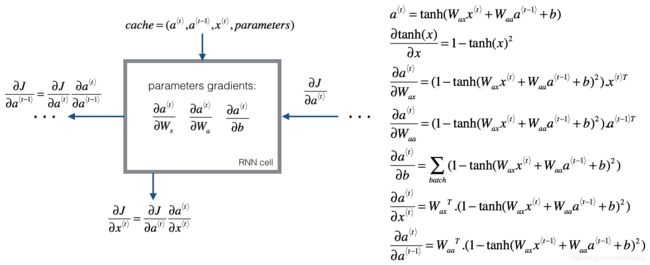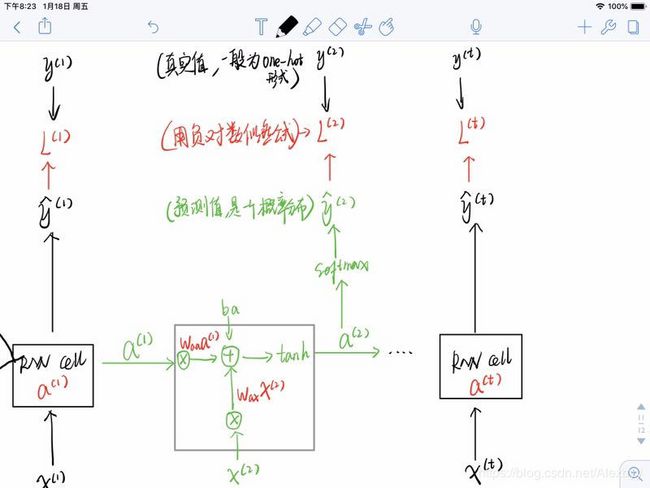【深度学习】传统RNN的正向传播与反向传播
循环神经网络的正向传播与反向传播
一、正向传播
前向循环计算公式:
a ( t ) = t a n h ( W a x x ( t ) + W a a a ( t − 1 ) + b a ) a^{(t)} = tanh(W_{ax}x^{(t)} + W_{aa}a^{(t-1)} +b_{a}) a(t)=tanh(Waxx(t)+Waaa(t−1)+ba)
y ( t ) = s o f t m a x ( W y a a ( t ) + b y ) y^{(t)} = softmax(W_{ya}a^{(t)} + b_{y}) y(t)=softmax(Wyaa(t)+by)
python实现rnn前向传播算法
# parameters是参数Waa、Wax、Wya、by、b等组成的字典
# a_prev是上一时间步的输出(a)
# x是训练数据
def rnn_step_forward(parameters, a_prev, x):
Waa, Wax, Wya, by, b = parameters['Waa'], parameters['Wax'], parameters['Wya'], parameters['by'], parameters['b']
a_next = np.tanh(np.dot(Wax, x) + np.dot(Waa, a_prev) + b) # hidden state
p_t = softmax(np.dot(Wya, a_next) + by) # unnormalized log probabilities for next chars # probabilities for next chars
return a_next, p_t
def rnn_forward(X, Y, a0, parameters, vocab_size = 27):
# Initialize x, a and y_hat as empty dictionaries
x, a, y_hat = {}, {}, {}
a[-1] = np.copy(a0)
# initialize your loss to 0
loss = 0
for t in range(len(X)):
# Set x[t] to be the one-hot vector representation of the t'th character in X.
# if X[t] == None, we just have x[t]=0. This is used to set the input for the first timestep to the zero vector.
x[t] = np.zeros((vocab_size,1))
if (X[t] != None):
x[t][X[t]] = 1
# Run one step forward of the RNN
a[t], y_hat[t] = rnn_step_forward(parameters, a[t-1], x[t])
if t==0:
print(y_hat[t].shape)
# Update the loss by substracting the cross-entropy term of this time-step from it.
loss -= np.log(y_hat[t][Y[t],0])
cache = (y_hat, a, x)
return loss, cache
二、反向传播
- 上图中的 L t L^{t} Lt是每一步计算出来的损失(用负对数似然公式),最终的总损失 L = ∑ ( L t ) L=\sum(L^{t}) L=∑(Lt)
- 负对数似然
神经网络的输出通常是概率分布,一般使用负对数似然来作为损失函数。例如:假设训练集Y的one-hot表示是(0,1,0),预测值y的分布为(0,1,0.6, 0.3),则对于该训练样本的损失loss=-log0.6,然后最小化该loss,目的是让预测值y与真实y相对应位置的概率尽量大。
如果X表示所有的输入,Y表示我们观测到的目标 θ M L = a r g θ m a x P ( Y ∣ X ; θ ) \theta_{ML} = arg_{\theta}maxP(Y|X;\theta) θML=argθmaxP(Y∣X;θ)
假设样本是独立同分布的,则上面公式实际情况是一连串训练样本的预测概率相乘,这种情况下可以用对数函数进行等价转换(方便计算): θ M L = a r g θ m a x ∑ i = 1 m l o g P ( y ( i ) ∣ x ( i ) ; θ ) \theta_{ML} = arg_{\theta}max\sum_{i=1}^mlogP(y^{(i)}|x^{(i)};\theta) θML=argθmaxi=1∑mlogP(y(i)∣x(i);θ)
对于循环神经网络,其损失函数是每一时间步损失的和,也就是上图中所有的L之和: L ( x ( 1 ) , . . . , x ( t ) , y ( 1 ) , . . . , y ( t ) ) = ∑ t L ( t ) = − ∑ t l o g P m o d e l ( y ( t ) ∣ x ( 1 ) , . . . , x ( t ) ) L({x^{(1)},...,x^{(t)}},{y^{(1)},...,y^{(t)}}) = \sum_{t}L^{(t)} = -\sum_{t}logP_{model}(y^{(t)}|{x^{(1)},...,x^{(t)}}) L(x(1),...,x(t),y(1),...,y(t))=t∑L(t)=−t∑logPmodel(y(t)∣x(1),...,x(t))
其中 P m o d e l ( y ( t ) ∣ x ( 1 ) , . . . , x ( t ) ) P_{model}(y^{(t)}|{x^{(1)},...,x^{(t)}}) Pmodel(y(t)∣x(1),...,x(t)) 需要读取模型输出向量y与真实向量y对应的项。
- RNN的反向传播需要按时间步从后往前推导(本质是一个优化问题和链式求导),我们要优化的目标函数就是总损失 L = ∑ ( L t ) L = \sum(L^{t}) L=∑(Lt)(最小化它),然后从t到0对其逐步求导。
例如求时间步t处,L对参数 W a y W_{ay} Way的偏导数:

3. RNN某一时间步内反向传播计算公式
python实现RNN反向传播算法
def rnn_step_backward(dy, gradients, parameters, x, a, a_prev):
gradients['dWya'] += np.dot(dy, a.T)
gradients['dby'] += dy
da = np.dot(parameters['Wya'].T, dy) + gradients['da_next'] # backprop into h
daraw = (1 - a * a) * da # backprop through tanh nonlinearity
gradients['db'] += daraw
gradients['dWax'] += np.dot(daraw, x.T)
gradients['dWaa'] += np.dot(daraw, a_prev.T)
gradients['da_next'] = np.dot(parameters['Waa'].T, daraw)
return gradients
""" Returns: parameters -- python dictionary containing: X -- 训练数据 Y -- 真实值 parameters -- dict,include:Waa,Wax,Wya,by,b cache--每一步的预测值y、a及训练样本x组成的字典 """
def rnn_backward(X, Y, parameters, cache):
# Initialize gradients as an empty dictionary
gradients = {}
# Retrieve from cache and parameters
(y_hat, a, x) = cache
Waa, Wax, Wya, by, b = parameters['Waa'], parameters['Wax'], parameters['Wya'], parameters['by'], parameters['b']
# each one should be initialized to zeros of the same dimension as its corresponding parameter
gradients['dWax'], gradients['dWaa'], gradients['dWya'] = np.zeros_like(Wax), np.zeros_like(Waa), np.zeros_like(Wya)
gradients['db'], gradients['dby'] = np.zeros_like(b), np.zeros_like(by)
gradients['da_next'] = np.zeros_like(a[0])
# Backpropagate through time
for t in reversed(range(len(X))):
dy = np.copy(y_hat[t])
dy[Y[t]] -= 1
gradients = rnn_step_backward(dy, gradients, parameters, x[t], a[t], a[t-1])
return gradients, a

